More and more insurance companies today focus on prevention to reduce claims. What if a lot of accidents can be avoided? With a goal of "Safer drivers, safer roads, fewer claims", companies reach out to Sentiance in need of tailor-made, high-end, yet affordable digital driver coaching applications. Together, we aim for increased awareness and, ultimately, behavioral change benefiting not only the end-users and our clients, but society as a whole.
Actionable technologies in line with cutting-edge behavioral change insights and state-of-the-art AI can be used beyond digital driver coaching. At Sentiance, we are fully committed to understanding clients’ needs and to sprout scientifically sound tools benefitting your customer base! Our team of behavioral scientists, designers, engineers, and IT specialists vouch for user-friendly technology ranging from app engagement features for behavior change to validation dashboards for clients to interpret the collected data. After all, we take pride in adding value to your business.
Digital Driver Coaching Process
This self-evidently requires careful detection and mapping of the client’s goals, targeting of specific behavioral patterns, and developing sound, user-friendly and constructive feedback for all parties involved and topical coaching advice when appropriate. What follows is a short description of the process in which we tackle the problem of dangerous driving.
Step 1: understanding specific behavior patterns
Properly understanding how a person drives on a day-to-day basis constitutes a crucial first step before behavior change can occur. To this end, Sentiance developed a driver coaching score (see Figure 1) tracking/scoring several behavioral components: (1) phone-induced distracted driving, (2) speeding, and (3) harsh movements (i.e, hard braking and harsh acceleration). The combination of these scores indicates whether the driver is doing poorly - okay - good or excellent, and this feedback is provided at a glance. Trips and driving events are detected automatically by our technology. A more technical description of our scores can be found here.
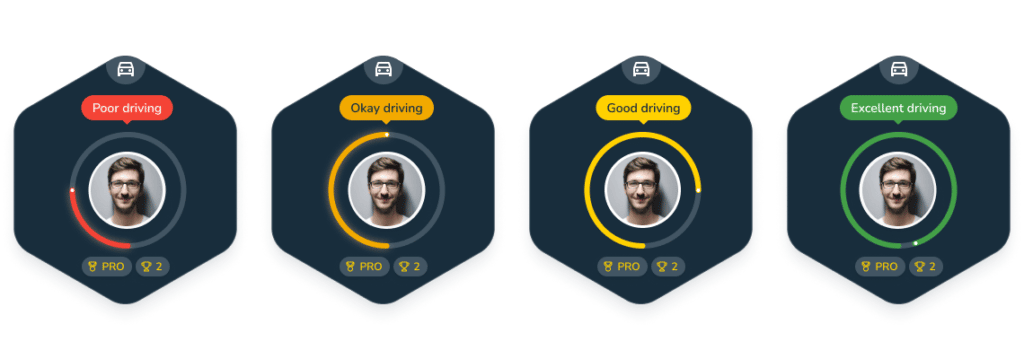

Different or equal weights can be attributed to the different components of the score depending on whether a client wants to focus more on specific dangerous driving behavior in the population. While a delivery company may find speeding to be more dangerous for its drivers, an insurer may want to tackle distracted driving in its population. For each client, we can tweak the score to their specific needs.
Step 2: developing scientifically sound tools to target specific behaviors
Research shows that theory-informed interventions are more likely to target theoretically consistent mechanisms of behavior change (Michie et al., 2018). The tools we develop to change behavior rely on scientific literature in psychology, sociology, and behavioral economics.
To address dangerous driving behaviors (i.e., the components of the driver coaching score), we combined the Stages of Change model (Diclemente & Prochaska, 1998) and Theory of Planned Behavior (Ajzen, 1991; 2011). These models describe psychological, social, and contextual factors to explain how behaviors develop and change over time.
The Stages of Change model sees change as a process for which people go through distinct stages before they make a (lasting) change. Interventions are tailored according to those stages: precontemplation, contemplation, preparation, action, maintenance, and termination (See Figure 2).
The original model was developed to describe how people can change addictive behaviors such as smoking and alcohol abuse but has since been used in many other domains. We consider the Stages of Change model an appropriate framework to change mobile phone use (in the context of driving) as mobile phone use has been described as a habitual behavior and can even turn into a behavioral addiction.
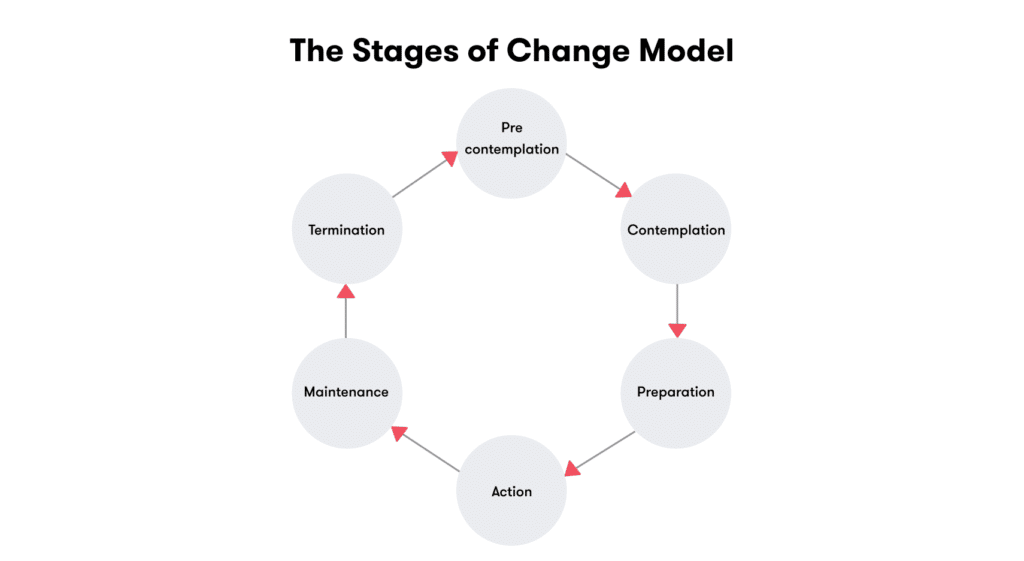
To change other dangerous driving behaviors such as speeding, hard braking and harsh acceleration, we use the Theory of Planned Behavior. This model assumes that people’s behaviors are determined by intention, which in turn depends on attitudes, subjective social norms, and perceived control (i.e. the perceived ability to change).
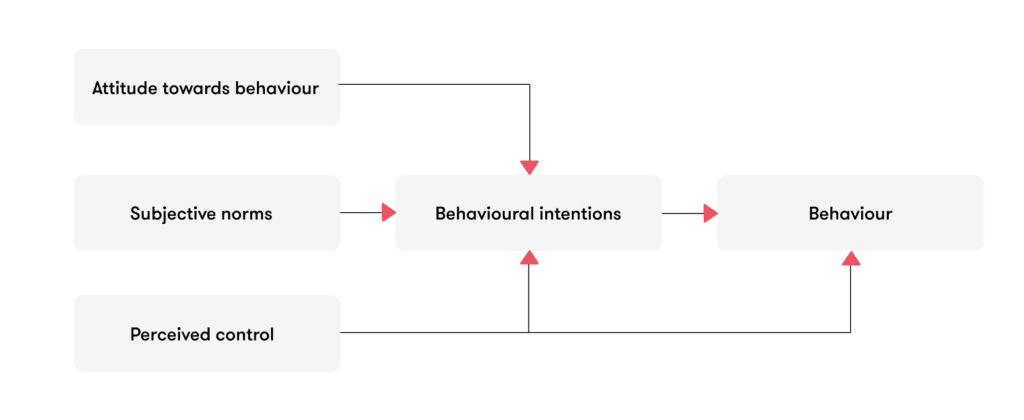
These two models form the basis of our application. Subsequently, we select behavior change techniques corresponding to the different components of these models (Michie et al., 2013). Behavioral change techniques are effective when they are aimed at important antecedents of the relevant behavior and removing barriers for change.
Once we have an understanding of the behavior and we have selected the behavior change techniques, we develop digital interventions in the form of app engagement features. For example, behavior change techniques such as self-monitoring and feedback are effective in making people aware of their behavior. Action planning and goal setting allow determining the goal to be achieved for each individual. Social comparison and support can create an online community that aids behavior change and retention of the app. In Table 1, you can find the behavior change techniques and app features to change (driving) behaviors. These features can be provided as a whole in a white label app, but can also be offered as off-the-shelf solutions.
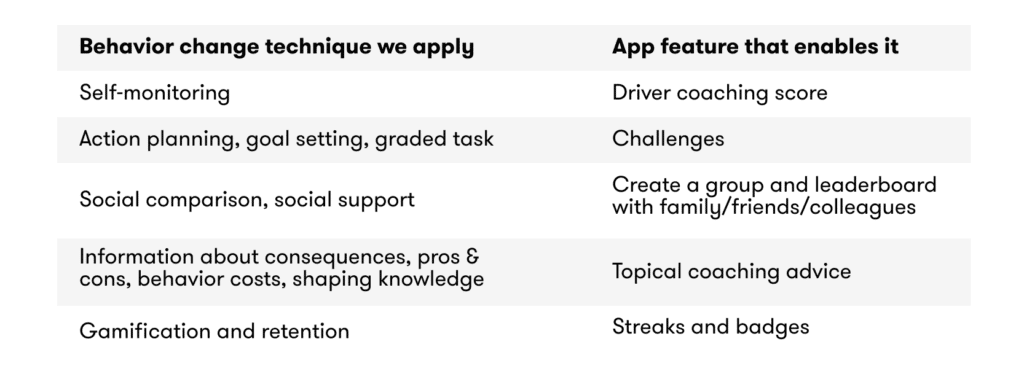
The information given in the topical coaching advice is in line with the two theories described above. We do not expect someone’s behavior to change straight away. Rather, we try to increase the driver’s awareness about observed dangerous driving, shift the driver’s mindset by addressing attitudes, norms and beliefs, and eventually observe a change in driving behavior. Furthermore, the coaching advice is tailored to the driver. Someone who violates the speed limit will receive content about speeding, while someone who uses their phone in the car will receive content related to distracted driving.

Step 3: Digital driver coaching dashboards and reporting
Finally, we keep a close eye on what is happening. Our data scientists create dashboards to provide real-time insights that are relevant to our clients (e.g. driving behaviors of different populations, the contexts, engagement with the application,....). We further analyze the data to observe whether change has occurred and write a detailed report to share with our clients.
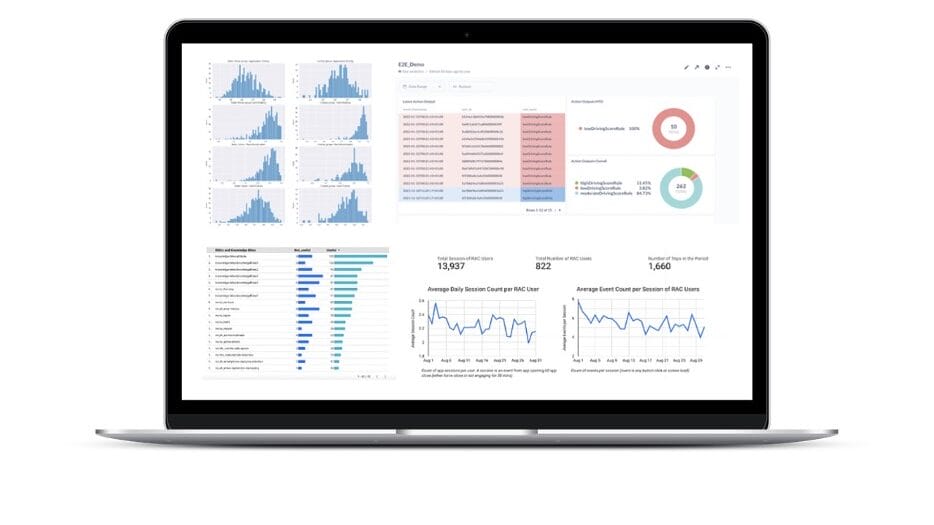
Moving forward
Our team’s acumen, technological savviness, and curiosity guarantee both optimal (understanding of the) user experience, clear reporting and actionable recommendations to secure the initial objectives of the client. Be it in the field of mobility (as described in this blog), sustainability, Sentiance ensures you to keep a finger on the pulse.
References
Ajzen, I. (1991). The theory of planned behaviour. Organizational Behaviour and Human Decision Processes, 50, 179-211.
Ajzen, I. (2011). The theory of planned behaviour: Reactions and reflections. Psychology & health, 26(9), 1113-1127.
DiClemente, C. C., & Prochaska, J. O. (1998). Toward a comprehensive, transtheoretical model of change: Stages of change and addictive behaviors. In W. R. Miller & N. Heather (Eds.), Treating addictive behaviors (pp. 3–24). Plenum Press.
Michie, S., Carey, R. N., Johnston, M., Rothman, A. J., De Bruin, M., Kelly, M. P., & Connell, L. E. (2018). From theory-inspired to theory-based interventions: a protocol for developing and testing a methodology for linking behaviour change techniques to theoretical mechanisms of action. Annals of behavioral medicine, 52(6), 501-512.
Michie, S., Richardson, M., Johnston, M., Abraham, C., Francis, J., Hardeman, W., ... & Wood, C. E. (2013). The behavior change technique taxonomy (v1) of 93 hierarchically clustered techniques: building an international consensus for the reporting of behavior change interventions. Annals of behavioral medicine, 46(1), 81-95.


